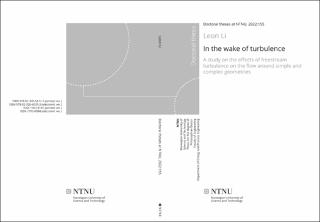| dc.contributor.advisor | Hearst, R. Jason | |
| dc.contributor.advisor | Worth, Nicholas | |
| dc.contributor.author | Li, Leon | |
| dc.date.accessioned | 2022-05-09T08:05:14Z | |
| dc.date.available | 2022-05-09T08:05:14Z | |
| dc.date.issued | 2022 | |
| dc.identifier.isbn | 978-82-326-6035-3 | |
| dc.identifier.issn | 2703-8084 | |
| dc.identifier.uri | https://hdl.handle.net/11250/2994679 | |
| dc.description.abstract | With the growing demand of global energy consumption and a need to reduce pollution caused by energy production from fossil fuels, renewable sources of energy are becoming increasingly necessary for the future sustainable development of our society. Wind energy offers an attractive option as one of the renewable sources, and a large body of work is currently ongoing to widen its implementation. This thesis seeks to contribute to this growing body through experimental investigations into how turbulent flows interact with wind turbines, both in part and in whole, and from that, gain insights into how the interactions impact their performance. The complex and turbulent environment of atmospheric boundary layers, in which wind turbines operate, presents an intriguing challenge. The work is divided into three main investigative topics: the spatial development of a turbulent boundary layer under decaying freestream turbulence, the effect of freestream turbulence on the performance of a wind turbine airfoil, and lastly, the near-field of a model wind turbine under turbulent shear flows.
The first investigation examined how a turbulent boundary layer evolves in the streamwise direction under the influence of decaying freestream turbulence. The experiment was performed in the new water channel facility at the Norwegian University of Science and Technology. The objective was to gain insight into the physics of a representative background flow that can be expected for wind turbines. Laser Doppler velocimetry was used to characterize both the freestream turbulence and the boundary layer. The main finding is that the effects of decaying freestream turbulence on the properties of the turbulent boundary layer diminish as they coevolve downstream. This is reflected in both the behaviour of the wake region in the boundary layer, as well as the peak in the velocity fluctuations near the wall.
The second set of experiments looked into how freestream turbulence affects the pressure and lift characteristics of a wind turbine airfoil. Pressure distributions are taken at different angles of attack and for different incoming turbulence intensities. It is found that increasing the freestream turbulence intensity generally increases the maximum lift for this airfoil, but it does not noticeably change the stall angle. Lift within the linear operating range also shows improvement with increasing turbulence intensity. However, for low turbulence intensities, a decrease in lift in the linear region is observed. Further analysis into the pressure fluctuation spectra near the trailing edge reveals the presence of periodic pressure fluctuations for these cases.
Lastly, moving from the component to the system level, a model wind turbine was placed in different turbulent shear flows generated by an active grid. Particle image velocimetry was used to capture the near-field around the model. It was found that the near-wake velocity deficit can be decomposed into a velocity deficit profile caused by a uniform inflow plus the incoming shear profile. The combined profile shows higher shear gradient on the high-velocity side of the incoming shear flow, and this in turn leads to higher turbulence production and thus higher velocity fluctuations. The turbine power fluctuations were found to be proportional to turbulence intensity, regardless of the shear profile, and the kinetic energy available in the flow for downstream turbines was also found to be mainly dependent on the incoming turbulence intensity.
Overall, this thesis examines the influence of turbulent flows on a wind turbine from the perspective of the background flow level, the component level, and lastly, the system level. The work provides new insights into how these three levels are affected by the presence of turbulence, and it is the hope of the author that it will contribute meaningfully to the field of wind energy and turbulence research, and become a building block upon which other works can be advanced upon. | en_US |
| dc.language.iso | eng | en_US |
| dc.publisher | NTNU | en_US |
| dc.relation.ispartofseries | Doctoral theses at NTNU;2022:155 | |
| dc.relation.haspart | Paper 1: Jooss, Yannick; Li, Leon; Bracchi, Tania; Hearst, Robert Jason. Spatial development of a turbulent boundary layer subjected to freestream turbulence. Journal of Fluid Mechanics 2021 ;Volum 911. https://doi.org/10.1017/jfm.2020.967 This is an Open Access article, distributed under the terms of the Creative Commons Attribution licence (CC BY 4.0) | en_US |
| dc.relation.haspart | Paper 2: Li, Leon; Hearst, R. Jason. The influence of freestream turbulence on the temporal pressure distribution and lift of an airfoil. Journal of Wind Engineering and Industrial Aerodynamics 2021 ;Volum 209. https://doi.org/10.1016/j.jweia.2020.104456 This is an open access article under the CC BY license | en_US |
| dc.relation.haspart | Paper 3: Li, Leon; Hearst, R. Jason; Ferreira, Manuel A.; Ganapathisubramani, Bharathram. The near-field of a lab-scale wind turbine in tailored turbulent shear flows. Renewable Energy 2020 ;Volum 149. s. 735-748 https://doi.org/10.1016/j.renene.2019.12.049This is an open access article under the CC BY license | en_US |
| dc.title | In the wake of turbulence: A study on the effects of freestream turbulence on the flow around simple and complex geometries | en_US |
| dc.type | Doctoral thesis | en_US |
| dc.subject.nsi | VDP::Technology: 500::Environmental engineering: 610 | en_US |
